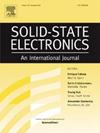Machine learning impassioned assessment of trap states driven band bending analysis in organic Schottky formation
IF 1.4
4区 物理与天体物理
Q3 ENGINEERING, ELECTRICAL & ELECTRONIC
引用次数: 0
Abstract
Band bending at metal–semiconductor junction bears significant consequences providing analytical explanation of built-in-voltage (Vbi) in current–voltage (I-V) relationship. Knowing the band bending impact on charge transition, a theoretical model has been developed which relates the parameter with geometrical conductance () by introducing modification in empirical Mott-Gurney law. The theoretical relation is validated with the approximated outcome of organic semiconductor-based prototype simulated device structure ranges between 100 nm to 900 nm. The same has been examined on two different experimental semiconducting dye based organic diode. For each case, the result reveals a greater range of consistency satisfying a well trend of analogy with theoretically developed equation. Band bending (b) shows inverse linearity with at increasing voltage, whereas the following investigation explore its proportional nature with increasing device thickness (L). Since organic materials are trap prone and its influence on charge conduction is well known, therefore, to predict the impact of trap distributions on b, machine-learning based modeling approaches has been undertaken to leverage the prediction in a reliable way to quantify the trap energy (ET). The comparison among different output set of computational modelling approach leads towards a non-linear approximation of b with variation of ET and is best applicable at 700 nm device thickness. Furthermore, different linear and non-linear Machine Learning algorithm has been trained for validation employing the considered sample thickness in experimental dye-based devices and based on the assessment of performance metrics, the influence of ET on variation of b has been detected.

有机肖特基地层中阱态驱动能带弯曲分析的机器学习激情评估
金属-半导体结带弯曲对电流-电压(I-V)关系中的内置电压(Vbi)有重要影响。考虑到带弯曲对电荷跃迁的影响,通过对经验莫特-格尼定律的修正,建立了一个将带弯曲参数与几何电导(gm)联系起来的理论模型。用有机半导体原型模拟器件结构在100 ~ 900 nm范围内的近似结果验证了理论关系。在两种不同的实验染料基半导体有机二极管上进行了同样的研究。对于每种情况,结果都显示出较大的一致性范围,满足了与理论推导方程的良好类比趋势。随着电压的增加,带弯曲(b)与gm呈反线性关系,而接下来的研究则探讨了其与器件厚度(L)的增加成正比的性质。由于有机材料容易产生陷阱,其对电荷传导的影响是众所周知的,因此,为了预测陷阱分布对b的影响,已经采用了基于机器学习的建模方法,以可靠的方式利用预测来量化陷阱能量(ET)。通过对不同计算建模方法输出集的比较,得出了b随ET变化的非线性近似,最适用于700nm器件厚度。此外,我们训练了不同的线性和非线性机器学习算法,利用实验染料基器件中考虑的样品厚度进行验证,并基于性能指标的评估,检测了ET对b变化的影响。
本文章由计算机程序翻译,如有差异,请以英文原文为准。
求助全文
约1分钟内获得全文
求助全文
来源期刊

Solid-state Electronics
物理-工程:电子与电气
CiteScore
3.00
自引率
5.90%
发文量
212
审稿时长
3 months
期刊介绍:
It is the aim of this journal to bring together in one publication outstanding papers reporting new and original work in the following areas: (1) applications of solid-state physics and technology to electronics and optoelectronics, including theory and device design; (2) optical, electrical, morphological characterization techniques and parameter extraction of devices; (3) fabrication of semiconductor devices, and also device-related materials growth, measurement and evaluation; (4) the physics and modeling of submicron and nanoscale microelectronic and optoelectronic devices, including processing, measurement, and performance evaluation; (5) applications of numerical methods to the modeling and simulation of solid-state devices and processes; and (6) nanoscale electronic and optoelectronic devices, photovoltaics, sensors, and MEMS based on semiconductor and alternative electronic materials; (7) synthesis and electrooptical properties of materials for novel devices.
 求助内容:
求助内容: 应助结果提醒方式:
应助结果提醒方式:


